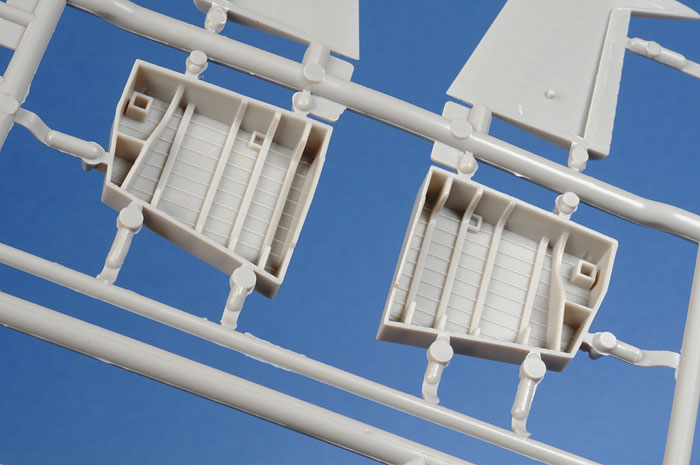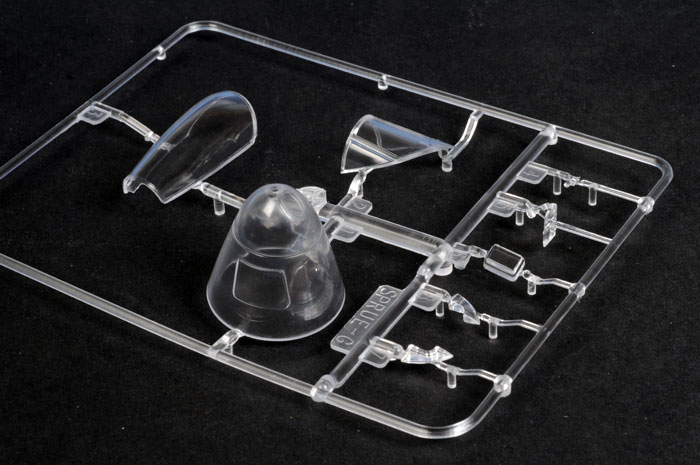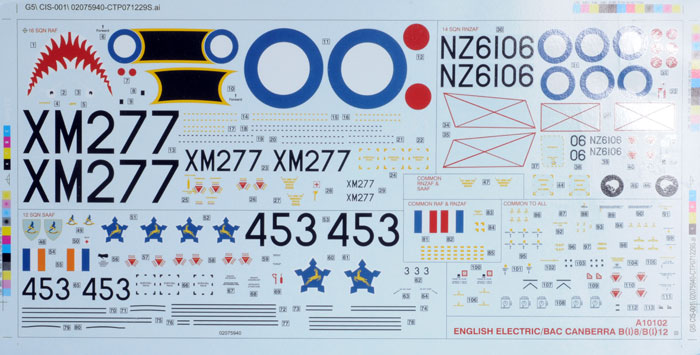|
Canberra B(I)8

Airfix, 1/48 scale
S
u m m a r y |
| Catalogue Number: |
Airfix Kit No. A10102 - English Electric Canberra B(I)8 |
| Scale: |
1/48 |
| Contents and Media: |
145 parts in grey coloured plastic; 8 clear plastic parts; decal sheet covering three marking options |
| Price: |
From GBP£23.82 plus shipping available online from Hannants |
| Review Type: |
FirstLook |
| Advantages: |
Excellent quality mouding; crisp and consistent recessed panel lines; separate control surfaces and entry doors; good selection of ordnance options; varied markings; stout packaging. |
| Disadvantages: |
Peculiar surface detail on rudder; some half-hearted elements in the cockpit; a number of large sprue attachment points |
| Recommendation: |
Highly Recommended |
Reviewed by
Brett Green

HyperScale is proudly supported by Squadron.com
The English Electric Canberra was a groundbreaking aircraft when it entered service in the early 1950s. The Canberra set and held many altitude, distance and speed records in its early years.
In addition to widespread and long service with the Royal Air Force, the English Electric Canberra was exported to many countries including Australia, New Zealand, Sweden, France, West Germany, India, Pakistan, Rhodesia, Ethiopia, Argentina, Chile, Ecuador, Peru and Venezuela.
The Canberra B(I)8 was designed for the interdiction role, encompassing a number of changes from the original B.2 production version. These included a revised "fighter" style cockpit with improved visibility, the ability to carry a wide range of ordnance, plus an optional Boulton Paul gun pack with four 20mm Hispano cannon.
Airfix continues its new production push with a new 1/48 scale Canberra B(I)8. This is the first time that a 1/48 scale injection moulded kit of the B(I)8 has been available.
Airfix's 1/48 scale Canberra B(I)8 comprises 145 parts in grey coloured plastic, 8 clear plastic parts and a large decal sheet covering three markings options for the RAF, RNZAF and South Africa. Parts are supplied to build either a B(I)8 or a B(I)12 variant, although not all the camera options are provided for the B(I)12.
Moulding quality is up to the same high standard as Airfix's recent Nimrod, and the surface detail appears slightly finer to my eye. The plastic parts are perfectly smooth, with crispy recessed panel lines throughout and no sink marks to be seen anywhere. Ejector pin marks on major and minor parts have mainly been thoughtfully positioned to be hidden when the model is built. The only exception that I can find are the interiors of the main gear doors, which do have a couple of faint circles, but these should be covered by the undercarriage legs. Some of the sprue attachment points are very thick though, so care will be required when removing parts and cleaning up the waste to avoid gouging the plastic.
Detail appears to be a little soft on the wheels, but they should look fine after careful painting. The only peculiarity worthy of mention is the deep engraved surface detail on the rudder. By coincidence, I was able to drop in and check out the Canberra at the Temora Aviation Museum to confirm that there is no surface detail on the control surfaces except some slight dimpling on the rudder. I will be filling and sanding the engraved lines on the kit rudder.
Exterior detail is good. In addition to the separate entry door, the model features positionable flaps, elevators and rudder, plus boxed-in wheel wells.

The large bomb bay has separate doors and may be posed open. Nearly two entire sprues are dedicated to bombs and rockets.
Cockpit detail is a bit basic. The seats and instrument panels will benefit from some extra detailing or replacement. If you choose to buils the kit straight from the box, though, little will be visible inside the black-painted cockpit anyway. Three crew figures are supplied in typical Airfix style (in other words, good).
Clear parts include the canopy (supplied in two clear pieces and one grey), nose cone and wing tip navigation lights.. The nose cone is moulded with the bottom observation window, so there will be minimal risk of smearing glue on the clear sections. Although the canopy has been moulded separately and can theoretically be posed open, the instructions correctly advise that it should only be secured in the closed position. Canberra canopies were fixed shut for all variants except the PR.9.
The transparencies are nice and clear.

Instructions are supplied in a 16 page stapled A4 booklet. Construction is covered in 39 illustrated steps. A separate full-colour foldout sheet is provided for stencil placement and four-views of each of the three marking options.
The three options are:
-
Canberra B(I)8, 16 Sqn RAF, Laarbuch Germany, 1972. This aircraft is finished in Dark Green and Dark Sea Grey with lower surfaces in silver.
-
Canberra B(I)12 of 14 Sqn, RNZAF at Ohkea, New Zealand in 1968. Finish is the same as above.
-
Canberra B(I) 12 of 12 Sqn SAAF, Waterfloof South Africa, 1969-1975. This aircraft is finished in overall High Speed Silver.

The decal sheet is large and very glossy. Saturation of the colours looks good. Non-primary colours have been printed using a dot screen method which is visible when viewed very close up, but the effect is less obvious this time - perhaps due to the darker colours.
We are not quite back to the halcyon days of the Spitfire Mk.22/24, the Seafire and Lightning with their magnificent surface texture and state-of-the-art detail, but Airfix continues to move in the right direction with their new 1/48 scale Canberra B(I)8 kit.
The model will be impressively large, offers good exterior detail and plenty of ordnance options.
Despite its size, this kit is quite conventional and simple in its parts breakdown. It should not present a challenge to modellers with a few kits under their belt.
I suppose that comparisons with the recent Classic Airframes Canberra will be inevitable. On the one hand, the Airfix kit offers more ordnance options, an open bomb bay, separate control surfaces and simple construction; while on the other hand Classic Airframes Canberras feature finer surface texture and better cockpit detail but it will undoubtedly be more of a challenge to build. Perhaps the most important point, though, is that Airfix and Classic Airframes offer completely different variants, so there is nothing stopping you from buying the Airfix B(I)8 even if you have a closet full of CA Canberras!
Highly Recommended.
Thanks to Hannants for the sample
Review Text and Images Copyright © 2008 by Brett Green
Page Created 22 February, 2008
Last updated
22 February, 2008
Back to HyperScale Main Page
Back to Reviews Page |
